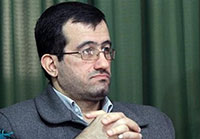The importance of auditory and visual memory in oral history
Hamid Ghazvini
Translated by: Fazel Shizrad
2019-9-11
 All humans have had the experience of remembering forgotten memoirs by seeing a particular object or photo, or hearing someone's voice. Such cases are directly related to human visual and auditory memory.
All humans have had the experience of remembering forgotten memoirs by seeing a particular object or photo, or hearing someone's voice. Such cases are directly related to human visual and auditory memory.
Psychologists believe that humans usually memorize their memories with a sign, such as a place or a particular image. For this reason, everyone, at first, tries to visualize mentally observations of past events and then expresses memories.
Experience and study of psychologists have shown that people who close their eyes while they are remembering memories are more successful. Because when they closed eyes, the connection between the mind and outside environment is disconnected and one can more easily visualize mentally.
This type of memory is widely used to learn and recognize lessons and skills related to childhood and school or to assist the elderly and to treat and control some mental and neurodegenerative diseases.
Some people have good visual and auditory memory and remember a lot of information as soon as they see a picture or hear a related sound, but there are also some who have serious problems.
One of the tasks of oral history interviewer is to stimulate this type of memory with the aim of reviving the interviewee's memories by asking detailed questions. Naturally, this may be difficult because of the passage of time or people's age. Sometimes different photos are replaced by other ones in narrator's mind and cause him to be encountered with trouble. It is even possible that a defective or inaccurate picture of some situations may be mistaken in expressing memories.
Some measures can be instituted to enhance and refine the visual and auditory memory, while patience and observance of the narrator's physical and mental state. It is important to note that stimulation of auditory and visual memory is a slow and careful process and any acceleration will impair the process.
Some measures are as follows:
1. Looking at old pictures and documents.
2. Watching movies that are directly or indirectly related to the subject of interview. (Documentary or fiction).
3. Listening to audio files at the same time.
4. Listening to the songs and music of that era.
5. Visiting some old friends and relatives and people related to the subject of interview.
6. Visiting some ancient objects.
7. Accompanying the narrator and visiting the interview areas and locations.
8. Tracing related images, such as a drawing of prison's room or operational area.
9. Seeing or referring to symbols of same era as flags, banners, tablets, etc.
10. Reading and repeating popular songs of slogans at the same time.
Number of Visits: 3421








The latest
Most visited
The Arab People Committee
Another event that happened in Khuzestan Province and I followed up was the Arab People Committee. One day, we were informed that the Arabs had set up a committee special for themselves. At that time, I had less information about the Arab People , but knew well that dividing the people into Arab and non-Arab was a harmful measure.Kak-e Khak
The book “Kak-e Khak” is the narration of Mohammad Reza Ahmadi (Haj Habib), a commander in Kurdistan fronts. It has been published by Sarv-e Sorkh Publications in 500 copies in spring of 1400 (2022) and in 574 pages. Fatemeh Ghanbari has edited the book and the interview was conducted with the cooperation of Hossein Zahmatkesh.Is oral history the words of people who have not been seen?
Some are of the view that oral history is useful because it is the words of people who have not been seen. It is meant by people who have not been seen, those who have not had any title or position. If we look at oral history from this point of view, it will be objected why the oral memories of famous people such as revolutionary leaders or war commanders are compiled.Daily Notes of a Mother
Memories of Ashraf-al Sadat SistaniThey bring Javad's body in front of the house. His mother comes forward and says to lay him down and recite Ziarat Warith. His uncle recites Ziarat and then tells take him to the mosque which is in the middle of the street and pray the funeral prayer (Ṣalāt al-Janāzah) so that those who do not know what the funeral prayer is to learn it.


